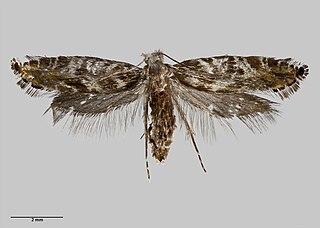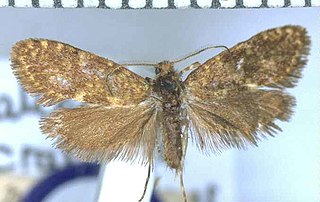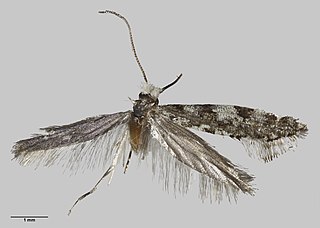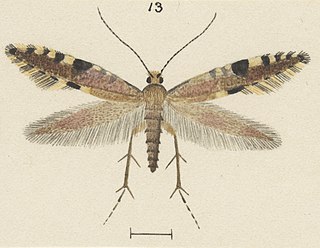
Heterocrossa contactella is a species of moth in the family Carposinidae. It is endemic to New Zealand.

Charixena iridoxa, also known as the Astelia zig-zag moth, is a moth of the family Plutellidae. It was first described by Edward Meyrick in 1916. This species is endemic to New Zealand and has been observed in the North, South and Stewart Islands. The life cycle of this moth is at least two years in length with the larvae inhabiting the bulb of its host plants and mining the underside of its leaves. These mines have a distinctive zig-zag appearance and can be easily recognised when looked for on the host plants. The larvae pupate in a cocoon attached to the leaf and this stage takes place between February and August. The adult moths emerge in the early spring and are fast, day flying moths. Their larval hosts are plants in the genus Astelia and include Astelia fragrans and Astelia nervosa.

Astrogenes chrysograpta, is a species of moth in the family Tineidae. It was described by Edward Meyrick in 1921 using a specimen collected by Stella Hudson on Mount Arthur in January. This species is endemic to New Zealand.

Aristotelia paradesma is a moth of the family Gelechiidae. It was described by Edward Meyrick in 1885 and is endemic to New Zealand. This species has been observed on both the North and South Islands. The larvae feed on Coprosma species creating and living in stem galls. The adults are on the wing from November to March and are attracted to light.

Tinea accusatrix is a species of moth in the family Tineidae. It was described by Edward Meyrick in 1916. However the placement of this species within the genus Tinea is in doubt. As a result, this species has been referred to as Tinea (s.l.) accusatrix. This species is endemic to New Zealand.

Tinea astraea is a species of moth in the family Tineidae. It was described by Edward Meyrick in 1911. However the placement of this species within the genus Tinea is in doubt. As a result, this species has been referred to as Tinea (s.l.) astraea. This species is endemic to New Zealand.
Tinea atmogramma is a species of moth in the family Tineidae. It was described by Edward Meyrick in 1927. However the placement of this species within the genus Tinea is in doubt. As a result, this species has been referred to as Tinea (s.l.) atmogramma. This species is endemic to New Zealand.
Tinea dividua is a species of moth in the family Tineidae. It was described by Alfred Philpott in 1928. However the placement of this species within the genus Tinea is in doubt. As a result, this species has been referred to as Tinea (s.l.) dividua. This species is endemic to New Zealand.

Tingena is a genus of the concealer moth family (Oecophoridae). This genus is endemic to New Zealand.

Mallobathra is a genus of moths belonging to the family Psychidae, and are bagworm moths. This genus was first described by Edward Meyrick. It is endemic to New Zealand. The type species of this genus is Mallobathra crataea.

Tingena homodoxa is a species of moth in the family Oecophoridae. It is endemic to New Zealand and is found in the southern parts of the South Island. It inhabits open grassy slopes and is on the wing from November until January.

Tingena plagiatella is a species of moth in the family Oecophoridae. It is endemic to New Zealand and has been observed in both the North and South Islands. This species inhabits light native bush or scrubland. Adults of this species are on the wing from November to January.

Tinea dicharacta is a species of moth in the family Tineidae. This species was first described by Edward Meyrick in 1893 and can be found in Australia. However, in 1911 Meyrick discussed specimens of an endemic to New Zealand moth, but placed it within this species. The taxonomy of this latter moth, although currently falling within this species, is regarded as being in need of revision. As such the moth discussed by Edward Meyrick in 1911 is also known as Tinea dicharacta sensu Meyrick, 1911 or Tinea (s.l.) dicharacta.

Tinea furcillata is a species of moth in the family Tineidae first described by Alfred Philpott in 1930. However the placement of this species within the genus Tinea is in doubt. As a result, this species may be referred to as Tinea (s.l.) furcillata. This species is endemic to New Zealand.

Tinea margaritis is a species of moth in the family Tineidae first described by Edward Meyrick in 1914. However the placement of this species within the genus Tinea is in doubt. As a result, this species may be referred to as Tinea (s.l.) margaritis. This species is endemic to New Zealand.

Tinea mochlota is a species of moth in the family Tineidae first described by Edward Meyrick in 1888. However the placement of this species within the genus Tinea is in doubt. As a result, this species may be referred to as Tinea (s.l.) mochlota. This species is endemic to New Zealand.

Tinea munita is a species of moth in the family Tineidae first described by Edward Meyrick in 1932. However the placement of this species within the genus Tinea is in doubt. As a result, this species may be referred to as Tinea (s.l.) munita. This species is endemic to New Zealand.

Tinea texta is a species of moth in the family Tineidae first described by Edward Meyrick in 1931. However the placement of this species within the genus Tinea is in doubt. As a result, this species may be referred to as Tinea (s.l.) texta. This species is endemic to New Zealand.

Tinea sphenocosma is a species of moth in the family Tineidae first described by Edward Meyrick in 1919. However the placement of this species within the genus Tinea is in doubt. As a result, this species may be referred to as Tinea (s.l.) sphenocosma. This species is endemic to New Zealand.

















